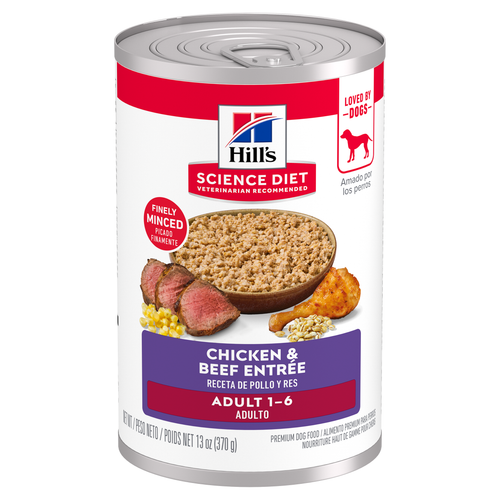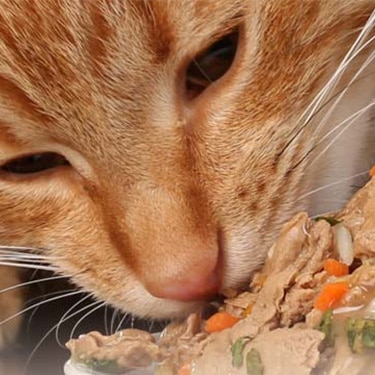
-
Find the right food for your petTake this quiz to see which food may be the best for your furry friend.Find the right food for your petTake this quiz to see which food may be the best for your furry friend.Featured products
 Adult Chicken & Barley Recipe Dog Food
Adult Chicken & Barley Recipe Dog FoodSupports lean muscle and beautiful coat for adult dogs
Shop Now Adult Large Breed Chicken & Barley Recipe Dog Food
Adult Large Breed Chicken & Barley Recipe Dog FoodSupports healthy joints, lean muscle, and beautiful coat for large breed dogs
Shop Now Hill's Science Diet Adult Chicken & Beef Entrée Dog Food
Hill's Science Diet Adult Chicken & Beef Entrée Dog FoodChicken & Beef Entrée in a delicious loaf with complete & balanced nutrition to help keep adult dogs active and healthy
Shop NowFeatured products Senior Vitality Adult 7+ Tuna & Vegetables Stew
Senior Vitality Adult 7+ Tuna & Vegetables StewImproves Everyday Ability to Get Up & Go
Shop Now Adult Turkey & Liver Entrée Cat Food
Adult Turkey & Liver Entrée Cat FoodPrecisely balanced nutrition with the delicious taste of minced turkey & liver to help fuel the energy needs of cats during the prime of their life
Shop Now Adult Tender No Corn, Wheat, Soy Chicken & Vegetables Stew Cat FoodShop Now
Adult Tender No Corn, Wheat, Soy Chicken & Vegetables Stew Cat FoodShop Now -
Dog
- Dog Tips & Articles
-
Health Category
- Weight
- Food & Environmental Sensitivities
- Urinary
- Digestive
- Joint
- Kidney
-
Life Stage
- Puppy Nutrition
- Adult Nutrition
- Senior Nutrition
Cat- Cat Tips & Articles
-
Health Category
- Weight
- Skin & Food Sensitivities
- Urinary
- Digestive
- Kidney
-
Life Stage
- Kitten Nutrition
- Adult Nutrition
Featured articles How to Properly Mix Wet & Dry Pet Foods
How to Properly Mix Wet & Dry Pet FoodsAn Orange cat eating from a bowl filled with mixed food
Read More What Is Littermate Syndrome? Pet Adoption Guide
What Is Littermate Syndrome? Pet Adoption GuideLearn more about littermate syndrome in dogs and cats and how to successfully navigate adoption and early socialization processes.
Read More The Science Behind Our Love for Pets
The Science Behind Our Love for PetsLearn the scientific reasons why we have such strong connections with our pets, and what science says about the love between humans and our furry friends.
Read More -


While you may have assumed that all dogs are natural swimmers, this isn't necessarily true. Yes, some dog breeds do well when they're in water, but other dog breeds may be more likely to struggle in the water no matter how much they dog paddle. Take a look at the list below of dog breeds that can't swim.
Which Dog Breeds Can't Swim?

As a rule, dog breeds that can't swim tend to have some common characteristics, says American Kennel Club (AKC). For example, brachycephalic breeds — those with flat faces or extremely short snouts — are generally unsuited for swimming because it's too easy to get water up their noses, making them a drowning risk. Dogs with large, barrel-shaped bodies struggle to stay afloat, as do dogs with long bodies and short legs. Dogs with long coats or thick double coats can also struggle with swimming. Finally, some breeds simply cannot withstand the shock to their system brought on by a plunge into cold water.
Wondering which dog breeds can't swim? Here are some of the more commonly known dog breeds that might prefer staying on land. If you have one of the following dog breeds listed below, it might be worth reconsidering those regular beach trips.
1. Bulldogs
Both English bulldogs and French bulldogs possess the triple threat of flat faces, barrel-shaped bodies and short legs. In other words, bulldogs simply aren't made for swimming. Only one of these traits would make swimming a challenge for these dogs, imagine having all three! So, in the land of dog breeds that can't swim, bulldogs are king.
2. Pugs
While pugs might enjoy wading and splashing in shallow water, their flat faces make breathing a challenge during the best of times. Add in the exertion of trying to keep their head above water, and it's hard to get pugs to stay above water. For many brachycephalic breeds, including pugs, keeping their faces above water means tilting their heads back so far that their back ends dip too low, says PetGuide.
3. Bull Terriers
Despite belonging to the active terrier group, the bull terrier's combination of short legs and a deep chest makes it struggle to stay afloat. Even the breed's close cousin, the Staffordshire bull terrier, who is a much larger dog, wouldn't necessarily make a better swimmer as the dense, heavy muscle and oversized head on this breed also presents a challenge for these dogs in the water.
4. Basset Hounds
Besides the fact that the body of a basset hound isn't designed for swimming (with their large heads and short legs that make it difficult to stay afloat), the large, floppy ears that are the trademark of this breed are prone to infections when water gets in the ear canal.
5. Boxers
This is another large, athletic breed you might think would be a natural-born swimmer. But the flat face on the boxer makes swimming just as dangerous for these dogs as it is for the more diminutive pug. The struggle to breathe and keep their noses above water means boxers may tire quickly and run the risk of drowning if in the water too long.
6. Corgis
Despite having an affinity for water, neither the Cardigan Welsh corgi nor the Pembroke Welsh corgi are strong swimmers. This is due to the combination of a long body, barrel-shaped chest and disproportionately short legs. So, it's best to let them enjoy splashing in shallow water.


Tasty Tips
7. Dachshunds
As with corgis, the elongated body and short legs of dachshunds make them poor swimmers. Even swimming in shallow water can tire the dachshund's little legs out to the point of danger. Keep a close eye on them when they're around any amount of water.
8. Shih Tzus
Like many of the smaller breeds, shih tzus have a number of disadvantages when it comes to swimming. Not only can the shortened muzzle and small legs make it difficult to keep their nose and mouth out of the water, but their long, full coat can weigh this breed down and also cover the face, making breathing even more of a challenge. These little dogs can also catch a chill from spending too much time in the water.
Water Safety for Dog Breeds that Can't Swim

If you're already the pet parent of one of these breeds, or you have a dog with similar physical characteristics, it's important to take steps to keep your pup safe around water (whether it's a pool or on a boat). Here are some helpful tips for things you can do:
Invest in a good doggie life jacket and put it on your pooch whenever they're near a body of water, including your swimming pool. Look for one made with waterproof materials that's rated for the size and weight of your dog, preferably with a handle on top that would allow you to quickly haul them to safety. The fit should be loose enough to be comfortable but tight enough that they won't slide out of it.
Stick to the shallows when taking your dog to the lake or beach. Encourage them to wade or splash in the water if they enjoy it, but don't force them to get in the water if they don't. Either way, keep them from wading in over their heads.
If you have a swimming pool, put a fence around it to keep your dog out.
The best fences aren't enough to keep some dogs out, so consider installing a ramp that would allow your dog to easily climb to safety if they fall in the pool.
It's also a good idea to teach your dog how to swim safely. The best method, says AKC, is to allow another dog to show your dog the ropes. Look for a friend's or neighbor's dog who is a good swimmer and who plays well with your pooch, and invite them over for a supervised play date in the pool. Your dog will learn what to do from watching the other dog. Just be sure your pup is wearing their life vest during their swimming lesson.
Supervise your dog closely at all times whenever they're around water, including shallow water.
- If you still want to provide your poor swimming dog a way to cool off in the heat of summer, consider investing in a small plastic kiddie pool. They're shallow enough to allow your dog to stand in the water, while still allowing them the fun of splashing in the pool.
Not all dogs are good swimmers, and this isn't an exhaustive list. Sometimes, even dogs who were bred for swimming and water activities don't enjoy swimming. Bath time aside, you should never force any dog who's averse to water to swim or play water sports. Dogs may have a built-in instinct for knowing how to dog paddle, but that doesn't always mean that they can tread water as easily.


Jean Marie Bauhaus is a pet parent, pet blogger, and novelist from Tulsa, Oklahoma, where she usually writes under the supervision of a lapful of fur babies.
Related products

Chicken & Beef Entrée in a delicious loaf with complete & balanced nutrition to help keep adult dogs active and healthy

Supports healthy joints, lean muscle, and beautiful coat for large breed dogs

Chicken & Barley Entrée in a delicious loaf with great taste and precisely balanced nutrition to support 5 essential building blocks for lifelong health

Supports lean muscle and beautiful coat for adult dogs
Related articles

Wondering where can I buy a dog? Consider adoption and explore the pros and cons of adopting a dog from a breeder versus an animal shelter.

Your dog's coat and skin are a big part of your dog's overall health. Ensure you keep your dog's coat healthy, by following these simple tips.

Discover how the field of dog science is giving us more and more insights into the inner workings of our furry best friends.

Learn how to help keep your dog's immune system in tip-top shape, including nutritional immune system support for dogs and other strategies.

Put your dog on a diet without them knowing
Our low calorie formula helps you control your dog's weight. It's packed with high-quality protein for building lean muscles, and made with purposeful ingredients for a flavorful, nutritious meal. Clinically proven antioxidants, Vitamin C+E, help promote a healthy immune system.
Put your dog on a diet without them knowing
Our low calorie formula helps you control your dog's weight. It's packed with high-quality protein for building lean muscles, and made with purposeful ingredients for a flavorful, nutritious meal. Clinically proven antioxidants, Vitamin C+E, help promote a healthy immune system.

